Eucalyptus globulus
Eucalyptus globulus
Eucalyptus (Eucalyptus globulus Labill., 1800) is a broad-leaved tree species belonging to the Myrtaceae family.
Systematics –
From the systematic point of view it belongs to the Eukaryota Domain, Kingdom Plantae, Magnoliophyta Division, Magnoliopsida Class, Myrtales Order, Myrtaceae Family and therefore to the Eucalyptus Genus and to the E. globulus Species.
Etymology –
The term of the genus Eucalyptus comes from the Greek ἐῧ éu true, well, to perfection and κᾰλυπτός kalýptos cover, hide: for the lobes of the chalice and the joined petals that form a cap that completely encloses the closed buds. The specific epithet globulus is the diminutive of globus globe, sphere, then spheres for the shape of the fruit.
Geographic Distribution and Habitat –
Eucalyptus is a native species of temperate Australia; the area of origin includes Tasmania and the southern coastal area of the state of Victoria. It was introduced into the Mediterranean basin in the mid-nineteenth century for forestry, ornamental and medicinal purposes, and was spread and spread especially along the coasts. In Italy we find it from Liguria to Sicily.
It is a heliophilous and thermophilous and quite rustic species.
Description –
The Eucalyptus globulus is a majestic and elegant tree that can reach 30 meters in height, with straight stem and arched branches, wide oval or irregular and smooth crown, of greenish-gray color that detaches from the stem in irregular longitudinal ribbons, allowing to glimpse the bark that is lighter, white or cream-colored and that over time becomes darker. The leaves are ovate in young plants, without petioles, opposite and smaller than adults; in mature plants they become linear and leathery, up to 30 cm long and 2-2.5 cm broad, falciform lanceolate, with acute apex and smooth margin, alternating and strongly aromatic. The plant bears solitary flowers or in groups of 2 three, yellowish white, composed of many stamens, 1-2 cm long, and without petals. The fruits are woody and hard hemispherical capsules, in the shape of a bell, with 4 ribs and a diameter of about 2 cm that contain many seeds.
Cultivation –
The Eucalyptus globulus has no particular pedological requirements and is also suitable for poor and shallow soils, nevertheless it shows its remarkable vegetative potential in the clayey and deep and sufficiently humid soils even in conditions of prolonged stagnation. For its cultivation it is possible to start from the seeds, with sowing in autumn and in heated environment. The planting must be done in the spring period. For the cultivation technique, see the following sheet.
Uses and Traditions –
The eucalyptus was, above all in the past years, an important forest essence. This plant, in fact, boasts a long history in our country; it was already present in Campania at the beginning of the 800 in the botanical garden annexed to the direction of Caserta and it was the Hortus Camaldulensis that gave the name to the Eucalyptus camaldulensis one of the most widespread species in Italy and in the world. The first installations in Italy date back to 1869 by the monks of the “Abbazia delle Tre Fontane” in Rome. The initial reasons for the diffusion of eucalyptus trees are linked to the belief that they could make the air healthier and counter the spread of malaria, due to the eucalyptus’ ability to quickly dry up the swampy areas by reducing and canceling the ability of the anopheles, vector of malaria , to multiply. At the beginning of the 20th century the eucalyptus arrived in Sicily where it was used in the “reclamation” interventions, in the “re-heating” of the dunes and along the railway lines. In the post-war period, eucalyptus cultivation developed in Italy and Sicily, thanks to the activity of the Center for Agricultural and Forestry Experimentation (Rome) founded in 1953, which focuses mainly on eucalyptus and poplar research. The expansion on large areas of eucalyptus in Sicily is linked to the expected use of the wood produced at the paper mill of Fiumefereddo (CT), which, in fact, will never open and to the intervention of the Cassa del Mezzogiorno.
From the leaves of this plantata he obtains eucalyptol, a mixture of terpenes used in the treatment of respiratory diseases. In herbal medicine is used mainly the essential oil, extracted by steam distillation of the fresh leaf of Eucalyptus globulus for the treatment of diseases affecting the respiratory system (cough, cold, etc.). It is composed of about 70% of cineol (or eucalyptol). It is hypothesized besides the secretolytic and expectorant effects also approved of the bactericidal and virostatic effects of other ingredients present in the essential oil that has properties: secretory, expectorant and mildly spasmolytic.
This is indicated for airway cooling diseases. Contraindications are inflammation of the gastrointestinal and biliary tract, severe liver disease. In infants and small children avoid direct application on the face and nose. Side effects: in rare cases may cause nausea, vomiting, diarrhea. In addition, some interactions may occur as the essential oil accelerates the metabolism of exogenous substances.
The eucalyptus flower is the floral emblem of the Australian state of Tasmania.
Preparation Mode –
The Eucalyptus globulus, in addition to forest applications and the use of its wood and for the extraction of eucalyptus, has no food uses.
Guido Bissanti
Sources
– Acta Plantarum – Flora of the Italian Regions.
– Wikipedia, the free encyclopedia.
– Treben M., 2000. Health from the Pharmacy of the Lord, Advice and experience with medicinal herbs, Ennsthaler Publisher
– Pignatti S., 1982. Flora of Italy, Edagricole, Bologna.
– Conti F., Abbate G., Alessandrini A., Blasi C. (edited by), 2005. An annotated checklist of the Italian vascular flora, Palombi Editore.
Attention: Pharmaceutical applications and alimurgical uses are indicated for informational purposes only, they do not in any way represent a medical prescription; there is therefore no liability for their use for curative, aesthetic or food purposes.


